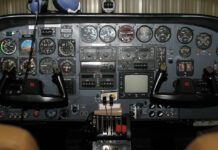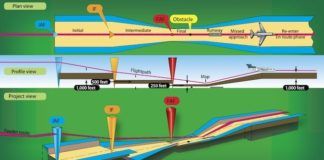Eagle County Regional Airport (KEGE) is the main airport that services the Vail ski area. At over 6000 feet field elevation, it presents many of the challenges of a high-altitude runway in the Rockies, and a few unique ones. Did I mention it is surrounded on all four sides by mountains reaching over 11,000 feet?
Flying into Eagle is certainly within the capabilities of a conservative, current, and qualified instrument pilot, but it’s one of those airports where pre-study of the approach and a little “armchair flying” are a must. (There is a very good reason a lot of commercial operators will restrict flights into Eagle to specially trained two-pilot crews.) Challenges you say?
Baby, It’s Cold Outside!
Brrr… the dreaded snowflake makes Eagle a cold temperature restricted airport. This has been covered here before, but let’s go through it again in case you want a refresher. At these airports, you must adjust your altitudes to compensate for the colder air mass and associated altimeter errors—you’ll be lower than your indicated altitude. (Remember “high (hot) to low (cold), look out below!”)
When the reported temperature is below -18 degrees Celsius at Eagle, you might need to fly corrected (higher) altitudes from the IAF all the way through the missed approach holding altitude. Don’t forget, you don’t change the barometric setting (Kollsman window); just fly your “new” higher calculated altitudes.
The -18 degrees for Eagle is noted next to the “snowflake.” Every cold temperature restricted airport can have a different baseline temperature, below which you need to make the adjustments. Oh, and yes, it gets that cold at Eagle. Sometimes even in the spring.
Unless you’re lucky enough to have an RNAV system that calculates the corrections for you—Honeywell’s APEX system on the PC-12/47E is one—you need to reference the ICAO cold Temperature Error Table found in the AIM section 7-2-3 and in the Terminal Procedure Publications front matter. If you don’t know how to find this chart in your EFB, just download and store it as a document.

Yikes! Math in Public
There are two methods you can use to calculate the corrections, “All Segments” and “Individual Segments.” Probably the most common method, and easiest to work out in flight, is “All Segments.” For the “All Segments” method:
- Take the Final Approach Fix (FAF) altitude, then subtract the airfield elevation. At KEGE, FAF altitude is 9800 feet, airport elevation is 6547 feet. 9800 − 6547 = 3253
- Enter the reported temperature. We’ll use -20 degrees to keep it simple and more conservative (bigger correction to keep us further from the ground).
- You can interpolate, then round to the nearest whole hundred (up or down). Since we’re interpolating, 3253 is approximately 25 percent between 3000 and 4000. The correction at 3000 feet for -20 is 420 feet, and it’s 570 at 4000 feet, or 150 feet higher. (570 − 420) × 0.25 = 37.5 that we’ll round to 38. Add 38 to 420 and our correction is 458. To be even more conservative, we’ll round that to 500 feet.
- Add that 500 feet to every altitude from the IAF to the FAF Altitude.
- “Lather. Rinse. Repeat”—do the same procedure for the MDA/DA and missed approach holding altitude.
The other procedure is the “Individual Segments” method. This method uses the same calculations as the “All Segments” method, but you only apply the correction to those segments called out in the NOTAM (so you have to look it up). In Eagle’s case, this year it’s only for the intermediate fix.
Find this in the NOTAM or via a link on the FAA website, at the bottom of the page where you search for the procedures at an individual airport.
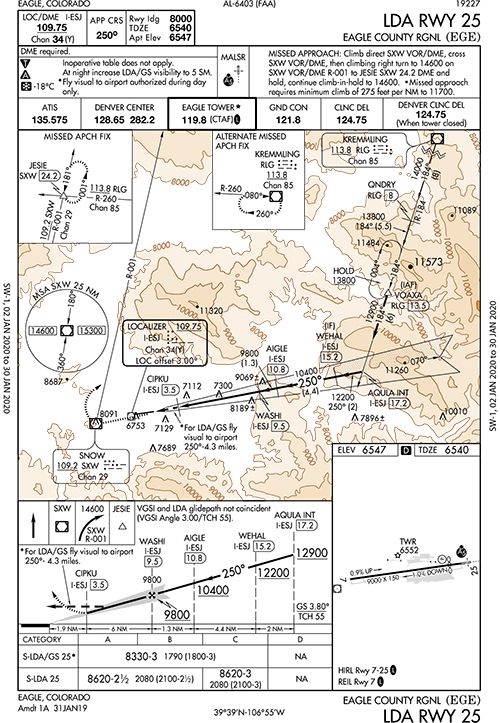
The Approach
The most common approach at Eagle, and the one with the lowest minimums, is the LDA RWY 25. Don’t expect Denver Center to vector you onto the approach. They’ll sequence you to the Kremmling VOR (RLG). See the sidebar on routing to Kremmling during the busy ski season.
Wait a minute; this is an “LDA/GS.” Isn’t an LDA with Glideslope the same as an ILS? Well … sort of. An LDA is a nonprecision instrument approach. It has the accuracy of a localizer but is not part of a complete ILS. LDAs needn’t be aligned with the runway, but straight-in minimums may be published (like at Eagle). Why this approach is not aligned with the runway becomes apparent the first time you fly the approach in visual conditions. The LDA is aligned slightly North—there’s a hill above your flight path to the South that encroaches into straight-in flight path safety zones about the vicinity of CIPKU. This hill will become important later.
The Airman’s Information Manual states “LDA/Glideslope … procedures fall under a newly defined category of approaches called Approach with Vertical Guidance (APV).” For you purists out there, APVs don’t meet the ICAO definition of a “Precision Approach.” The Pilot Controller Glossary reaffirms that an LDA is a nonprecision approach, and it doesn’t address LDAs with Glideslope, so for alternate considerations, it’s a non-precision approach. Before you think “800 & 2, got it,” note the saying Eagle has non-standard alternate requirements.
Airport Congestion
Eagle County becomes extremely popular during the ski season, especially around the holidays and spring break. It’s not uncommon to be sent to a hold on a beautiful VFR day simply because there is no parking available on the ramp. After landing I have personally spent over 45 minutes on the taxiway waiting for ramp space —after a 30-minute hold at Kremmling VOR.
Eagle was once included in the FAA’s Special Traffic Management Program (STMP). STMP is used for many high-volume special events like flying to the Super Bowl. Thankfully, that process for Eagle County has gone away to be replaced by Seasonal Traffic Management Initiatives (TMIs).
TMIs can include miles in trail, required routing, ground delay programs, airspace flow programs, or ground stops. Eagle’s TMI involves required routing. Coming from the southeast you can expect routing south then west of Eagle to approach Kremmling north of the airfield—the long way around. Plan your fuel accordingly. You can see the required routing in the ATC Command Center Advisories. As of this writing, winter 2019/20 routings haven’t been published, but here’s a sample routing from last year:
Eagle is definitely one of those airports where you should always carry extra fuel and plan an alternate.
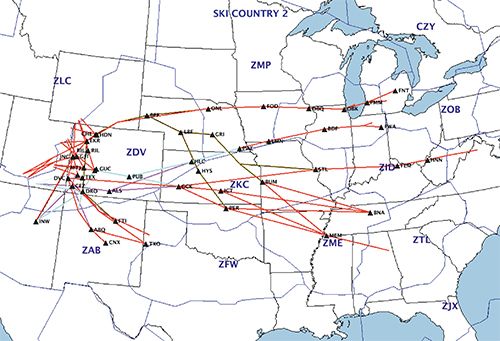
Alternate
Things can change quickly at Eagle—parking challenges, single runway operations, and highly dynamic mountain weather—so I always file an alternate. My “go-to” alternate for Eagle (and Aspen for that matter) is Rifle Garfield County (KRIL). Rifle is only 38 NM away from Eagle but sits 1000 feet lower. With weather frequently similar to Eagle’s, it often gives you an extra cushion below the weather. Additionally, Rifle has an ILS. Because it is so close, things will happen quickly. Don’t let Denver Center “help” you with an approach until you’re ready. If needed, ask for a hold at JESIE (the LDA’s missed approach hold) so you can prepare for that clearance to Rifle. —BW
Flying the Approach
What’s all this mean to us? Well, you’ll fly the approach the same way you fly an ILS. Fly to the published decision altitude (DA), but you’ll have a slight turn (three degrees—see the note in the localizer frequency box) to align with the runway. But wait, there’s more.
It’s daytime, and the reported visibility is three miles. Will you see the runway when you arrive at the DA? No, not if your inflight visibility is also three miles. Look closely at the “dashed” arrow on the profile view.
This approach has a published visual segment. Per the AIM, this segment “should be flown as a ‘DR’ course.” That DR (dead reckoning) course is 250 degrees for 4.3 miles, so with only three miles vis you have to fly 1.3 miles further until you see the airport. Here you have the rare situation where you don’t execute the missed approach procedure at the decision altitude on a glideslope. A “gotcha” here is that you’re flying a procedure that looks a lot like an ILS. Of course, you also can’t descend lower until you see the runway environment as listed in §91.175.
Recall that hill I said would become important? If you get to your DA and you can see that hill off to your left, you have the requisite three miles of in-flight visibility because that hill is approximately 1.3 miles from the end of the runway.
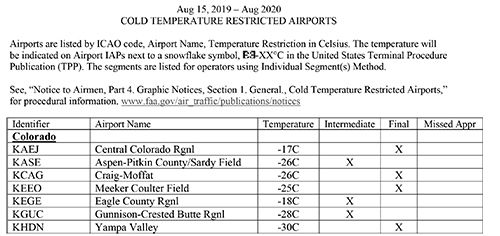
Switch It Up
Consider the same approach but at night. Will you see the runway at DA? Yes you will. That published visual segment of the approach, is daytime only. At night the visibility increases to five miles.
Here’s another oddity: The “ILS-like” approach with vertical guidance (S-LDA/GS) will get you lower, but the “plain” S-LDA (no GS) allows lower visibility. For Category A and B, you only need 2.5 miles. This is something to have ready if you have a good ceiling but poor visibility—think snow flurries.
Last, note that there are no circling mins. Better hope for favorable winds.
On the Miss
Because of the terrain—there’s another good-sized hill off the departure end of 25—Eagle requires a climb gradient of 275 feet per NM all the way up to 11,700 feet. This performance requirement is definitely something to include in your preflight planning. Leaving that discovery until your pre-approach briefing, or worse, overlooking it altogether, could lead to cumulogranite. If the missed climb requirements don’t get your attention, check out the MEEKER THREE departure and the curving flight path right after takeoff due to this hill.
Eagle offers a fun and challenging approach. Give it a try—but maybe under VFR the first time.




